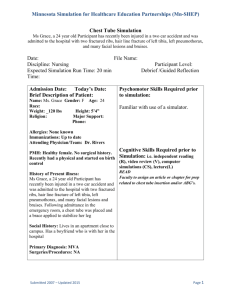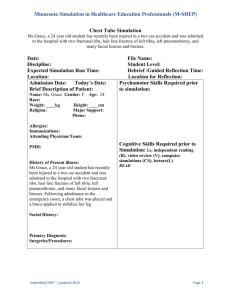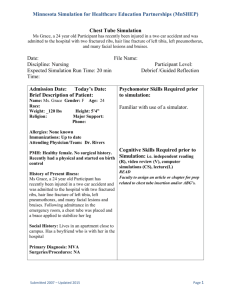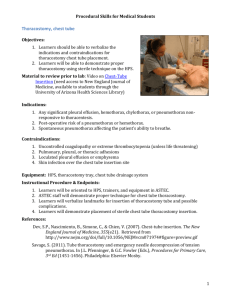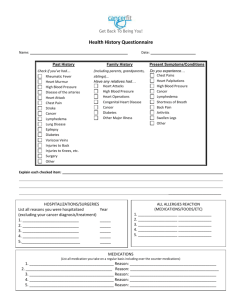Chest Tube Simulation - HealthForce Minnesota
advertisement
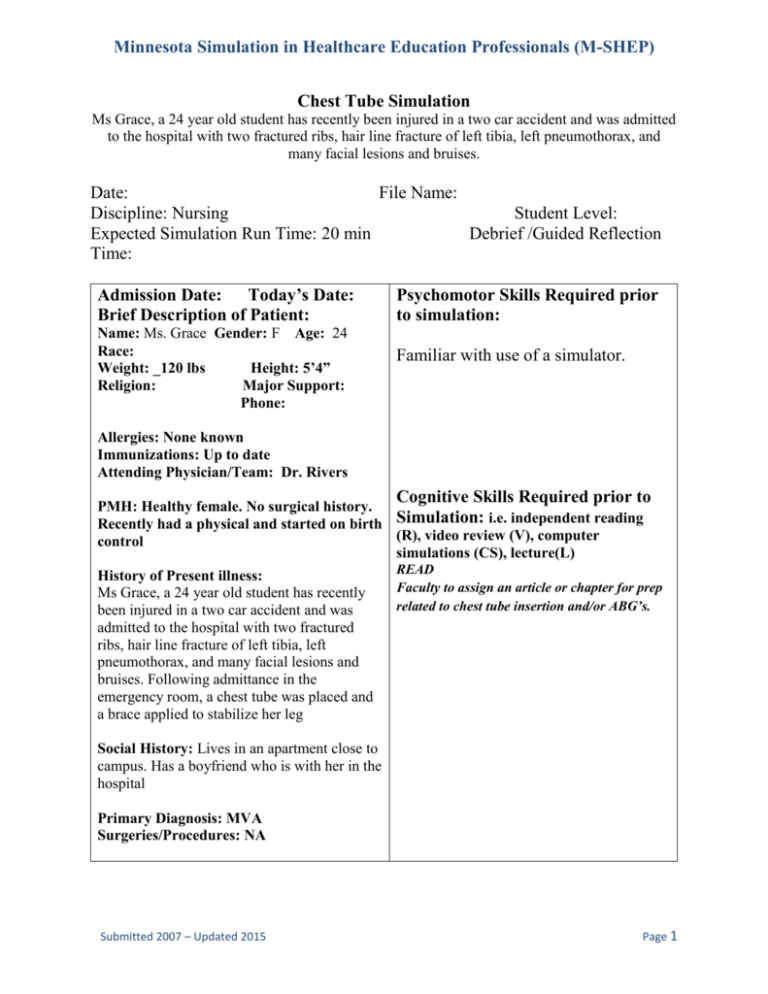
Minnesota Simulation in Healthcare Education Professionals (M-SHEP)
Chest Tube Simulation
Ms Grace, a 24 year old student has recently been injured in a two car accident and was admitted
to the hospital with two fractured ribs, hair line fracture of left tibia, left pneumothorax, and
many facial lesions and bruises.
Date:
File Name:
Discipline: Nursing
Student Level:
Expected Simulation Run Time: 20 min
Debrief /Guided Reflection
Time:
Admission Date: Today’s Date:
Brief Description of Patient:
Name: Ms. Grace Gender: F Age: 24
Race:
Weight: _120 lbs
Height: 5’4”
Religion:
Major Support:
Phone:
Psychomotor Skills Required prior
to simulation:
Familiar with use of a simulator.
Allergies: None known
Immunizations: Up to date
Attending Physician/Team: Dr. Rivers
Cognitive Skills Required prior to
PMH: Healthy female. No surgical history.
Recently had a physical and started on birth Simulation: i.e. independent reading
(R), video review (V), computer
control
simulations (CS), lecture(L)
History of Present illness:
Ms Grace, a 24 year old student has recently
been injured in a two car accident and was
admitted to the hospital with two fractured
ribs, hair line fracture of left tibia, left
pneumothorax, and many facial lesions and
bruises. Following admittance in the
emergency room, a chest tube was placed and
a brace applied to stabilize her leg
READ
Faculty to assign an article or chapter for prep
related to chest tube insertion and/or ABG’s.
Social History: Lives in an apartment close to
campus. Has a boyfriend who is with her in the
hospital
Primary Diagnosis: MVA
Surgeries/Procedures: NA
Submitted 2007 – Updated 2015
Page 1
Minnesota Simulation in Healthcare Education Professionals (M-SHEP)
Simulation Learning Objectives:
1. Identify indications for use of chest tubes
2. Identify the nursing responsibilities involved during insertion, maintenance, and removal
of chest tubes
3. Explain the nursing assessment necessary during insertion, maintenance, and removal of
a chest tube
4. Discuss the complications associated with chest tube drainage and the nursing actions
necessary for dealing with each complication
Fidelity
Setting/Environment
o Med-Surg
Simulator Manikin/s Needed:
Vital Sim or High fidelity manikin
Medications and Fluids
o IV Fluids: 0.9% NS @ 100 cc/hr
o Oral Meds:
o IVPB: Morphine syringes
Props:
Equipment attached to manikin:
o IV tubing with primary line 0.9% NS
fluids running at 100 cc/hr
o Foley catheter ________cc output
Equipment available in room
o
o
o
o
o
o
o
o
o
o
o
o
o
Bedpan/Urinal
Foley kit
Straight Catheter Kit
Incentive Spirometer
Fluids
IV start kit
IV tubing
IVPB Tubing
IV Pump
Feeding Pump
Pressure Bag
02 delivery devices type
Crash cart with airway devices and
emergency medications
o Defibrillator/Pacer
o Suction
Submitted 2007 – Updated 2015
o IV Push: 8mg Morphine Sulfate
o IM or SC:
Diagnostics Available
o
o
o
o
Labs
X-rays (Images)
12-Lead EKG
Other
Documentation Forms
o
o
o
o
o
o
o
o
o
o
o
Physician Orders
Admit Orders
Flow sheet
Medication Administration Record
Kardex
Graphic Record
Shift Assessment
Triage Forms
Code Record
Anesthesia / PACU Record
Standing (Protocol) Orders: Time out
Record
o Transfer Orders
Page 2
Minnesota Simulation in Healthcare Education Professionals (M-SHEP)
o Other: Chest tube set up/Sterile
supplies
Roles / Guidelines for Roles
o
o
o
o
o
o
o
o
o
o
o
o
o
o
o
o
o
Primary Nurse
Secondary Nurse
Clinical Instructor
Family Member #1
Family Member #2
Observer/s
Physician / Advanced Practice Nurse
Respiratory Therapy
Anesthesia
Pharmacy
Lab
Imaging
Social Services
Clergy
Unlicensed Assistive Personnel
Code Team
Other
Important information related to
roles:
Critical Lab Values: ABG’s/ C7
Physician Orders:
Admit to Med/Surg
Obtain ABS’s C7
O2 to keep sat’s above 90 %
Morphine 4 mg IV for pain
NPO
chest tube insertion: left Pneumothorax
20 cm/suction
IV 0.9 NS @ 100 ml/hr.
Submitted 2007 – Updated 2015
Other Props
Recommended Mode for simulation:
Student Information Needed Prior
to Scenario:
Has been oriented to simulator
Understands guidelines /expectations for
scenario
Has accomplished all pre-simulation
requirements
All participants understand their assigned
roles
Has been given time frame expectations
Report students will receive before
simulation:
Time:
Ms. Grace is admitted to the medical unit
for continued observation. You are the
admitting nurse of the patient as she
comes onto the floor.
Prior to leaving the emergency room, she
was given morphine sulfate 8 mg IVP for
pain that she rated as a “7” on a scale of
0-10.
Her vital signs were as followed: 99.5,
96, 16, and 112/68. Her skin is pale, dry,
and warm.
She has a # 18 IV in her Right hand that
has 0.9% NS infusing at 100cc/hr.
She is accompanied by her boyfriend
Her parents who lives out of town have
been contacted.
Page 3
Minnesota Simulation in Healthcare Education Professionals (M-SHEP)
References, Evidence-Based Practice Guidelines, Protocols, or Algorithms
used for this scenario:
Assessment Technologies Institute, LLC. (2013). Content mastery series-RN edition (9th
ed.).[On-line]. United States: Assessment Technologies.
Bauman, M., Handley, C. (2011) Chest-tube care: The more you know, the easier it gets.
American Nurse today, 6, (9), 28-32.
Submitted 2007 – Updated 2015
Page 4
Minnesota Simulation in Healthcare Education Professionals (M-SHEP)
Scenario Progression Outline
Timing
Manikin Actions
(approximate)
Initial assessment/
hospital room.
*chest tube
(wet/dry)
connected to 20cm
of suction.
Later in shift
Pt is repositioned in
bed to left side with
pillows
Chest tubing
becomes kinked
under patient
Day 2
Patient was up and
ambulated through
the night with
assistance and
wheelchair.
Expected Interventions
May use the
following Cues:
Vitals: 99.3, 88, 18, 104/64
Skin: warm, dry, pale
Lung sounds: clear on right,
diminished on left
Heart sound: RRR
Pedal pulses: PPP X 2
Edema: 2+ non-pitting in left
ankle and lower leg
Chest tube: 20cm of suction
Complete assessment.
Identify abnormal of assessment, if any.
Check for tidaling
Assessment of pain
Role member providing
cue: Patient
Vitals: 98.7, 96, 22, 126/82
Skin: warm, moist, pale
Lung sounds: clear on right,
diminished on left
Heart rate: RRR
Pedal pulses: PPP X 2
Edema: 2-3+ non-pitting in left
ankle and lower leg
Chest tube: 20 cm of suction,
NO tidaling is noted
Pt c/o of SOB, occasionally
coughing
Vitals: 98.2, 88, 20, 118/78
Skin: warm and dry, and pink
Bruising noted to left lower leg
and ankle
Lung sounds: clear on right,
diminished on left
Heart rate: RRR
Assessment of vitals and lungs sounds
with change in patient’s status
Assessment of chest tube and chamber
Identifies kink in tubing and releases.
Ensures that apparatus is functioning
correctly prior to leaving pt.
Call light in reach.
Role member providing
cue:
Complete assessment
Identifies abnormal and indicates
interventions
Identifies bubbling in water seal chamber
and identifies site of leaking.
Occludes tubing at insertion site
Bubbling stops
Role member providing
cue:
Submitted 2007 – Updated 2015
Cue: Moaning, holding
left side and states pain.
Cue:
Cue
Page 5
Minnesota Simulation in Healthcare Education Professionals (M-SHEP)
Scenario Progression Outline
Timing
Manikin Actions
Expected Interventions
(approximate)
Day 2
Pt up and ambulating
in halls with family.
Back to room and
resting in bed.
Day 2/
Doctor has just
replaced chest tube
and x-ray was
complete.
Nurse is leaving shift
for the day. Telling
patient good-bye
Pedal pulses: PPP X2
Edema: 2-3+ non-pitting in left
ankle and lower leg
Chest tube: 20 cm of suction,
tidaling is noted as well as
bubbling in water seal chamber
Vitals: 98.0, 110, 26, 178/90 O2
sat: 91 and dropping
Lung sounds: Clear on right,
absent on left
Heart rate: RRR, tachycardia
Pedal pulses: PPP x 2
Edema: 2-3+ non-pitting in left
ankle and lower leg
Chest tube: 20cm of suction,
pulled out of insertion site
PT c/o of pain at insertion site
and increasing SOB, difficulty
talking, coughing
As leaving room, chest tube
chamber is accidentally kicked
over – System is now open to
air
May use the
following Cues:
OR bubbling continues and
continues to move clamp down
tubing
OR bubbling continues to
chamber
Completes vitals and assessment at
change in status
Identifies chest tube pulled from
insertion site and performs correct
interventions
Instructs pt to exhale
Covers insertion site with Vaseline
dressing
HOB up
Applies O2
Immediately call MD
Monitors for tension pneumothorax
Role member providing
cue:
Role member providing
cue:
Submitted 2007 – Updated 2015
Assess the chamber system
Places tip of chest tube in a bottle of
sterile saline
Changes drainage system
Reconnects tubing
Cue:
Cue:
Page 6
Minnesota Simulation in Healthcare Education Professionals (M-SHEP)
Debriefing / Guided Reflection Questions for this Simulation:
Link to Participant Outcomes and Professional Standards
(i.e. QSEN, NLN {Nursing}, National EMS Standards {EMS}, etc.)
1. What were your primary concerns in this scenario?
2. Did you miss anything in getting report on this patient?
3. Did you have sufficient knowledge/skills to manage this situation?
4. What were your safety concerns for this patient?
5. What were your primary nursing diagnoses in this scenario? What nursing interventions
did you use, what outcomes did you measure? Where is your patient in terms of these
outcomes now?
6. What did you do well in this scenario?
7. If you were able to do this again, what would you do differently?
Complexity – Simple to Complex
Suggestions for changing the complexity of this scenario to adapt to different
levels of learners:
Submitted 2007 – Updated 2015
Page 7
Minnesota Simulation in Healthcare Education Professionals (M-SHEP)
SIMULATION SCENARIO
Chest tube
Student Copy
LEARNING OBJECTIVES
1.
2.
3.
4.
Identify reasons for chest tube insertion
Describe the different types of chest tube drainage systems
Discuss the preparation of the patient prior to chest tube insertion
Identify the nursing responsibilities involved during insertion, maintenance, and removal
of chest tubes
5. Explain the nursing assessments necessary during insertion, maintenance, and removal of
a chest tube
6. Discuss the complications associated with chest tube drainage and the nursing actions
necessary for dealing with each complication
SUPPLIES NEEDED
PATIENT DATA
Ms Grace, a 24 year old student has recently been injured in a two car accident and was admitted
to the hospital with two fractured ribs, hair line fracture of left tibia, left pneumothorax, and
many facial lesions and bruises. Following admittance in the emergency room, a chest tube was
placed and a brace applied to stabilize her leg. Ms. Grace is admitted to the medical unit for
continued observation. You are the admitting nurse of the patient as she comes onto the floor.
Prior to leaving the emergency room, she was given morphine sulfate 8 mg IVP for pain that she
rated as a “7” on a scale of 0-10. Her vital signs were as followed: 99.5, 96, 22, and 112/68. Her
skin is pale, dry, and warm. Her chest tube is at 20cm of suction. She has a # 18 IV in her Right
hand that has 0.9% NS infusing at 100cc/hr. She is accompanied by her boyfriend and her
parents who live out of town have been contacted.
REFERENCES
Assessment Technologies Institute, LLC. (2013). Content mastery series-RN edition (9th
ed.).[On-line]. United States: Assessment Technologies.
Bauman, M., Handley, C. (2011) Chest-tube care: The more you know, the easier it gets.
American Nurse today, 6, (9), 28-32.
Submitted 2007 – Updated 2015
Page 8
